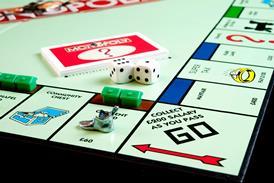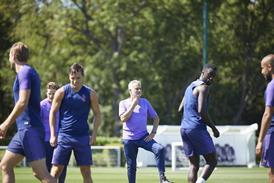Hey, maybe we could have an interactive kinda thingy on this," thinks producer after successful first series. That's been the way most interactive elements have come about. But that's just not good enough these days.
Increasingly, an interactive element is part of the programme proposal. Commissioning editors are coming to, if not exactly require it, at least expect producers to have thought about it.
Perhaps the first thing to think about is whether it makes commercial sense. Interactive elements tend to add around 10% to the budget. But if an interactive application promises to bring in, say, 20% of the budget, you don't have to be Carol Vorderman's smarter sister to do the maths. Whether it's commercial or not, the key to a winning interactive application is to bring added value to the show for the viewer. And, please note, added value is not the same as added weight.
"A lot of programme-makers come to it saying it would be great to have a director's commentary," says BBC interactive producer Mark Goodchild. "I go, well, yeah, it would be great if you were Martin Scorsese.
"This isn't just an easy way to get a bit of extra content out there. The question is, if it's so compelling why aren't you doing it in the main programme? It's got to be justifiable like any other content on television."
Below are a selection of case studies which show interactivity in action, whether it's linked to a live format or a mobile phone.
Live interactivity
All live shows are scary but live interactive shows are scary with red interactive knobs on. Getting it right on the night is the key to Granada's Great British Spelling/Pop/Driving Test shows.
What made it work, technically, is that the interactive application was developed with the show, not as an add-on. "We advised the show's graphic designer on what the interactive assets would look like, how they should be put together, then we built the service, tested the synchronisation and effectively broadcast that on the night in synchronisation with the live show," says Dominic Laval, chief operating officer at the interactive application company Emuse.
The shows were broadcast out of TV Centre with Emuse overlooking the interactive element. "We had one person playing out the service, one gallery person and one person in reserve in case of any problems," says Laval.
There were certainly no commercial problems. ITV had around 65,000 people paying£1 each to play along with each show. Not a bad return for interactive costs of£20,000 to£30,000 per show.
For the broadcaster, the trickiest thing is making sure the interactive instructions don't put people off, including those who just want to watch the show and not get interactive - still the vast majority, of course.
"There's a danger sometimes where you overload the intro of a show with information about how to join in rather than just getting on with it," says ITV interactive commissioner Debbie Mason. "We've got to come up with modern ways using the syntax of TV to get people involved so that the show can still kick off quicker."
However sophisticated the technology it's still down to the on-screen presenters to make it work for the viewer.
"Ultimately it's the presentation and talent that get the viewer to commit to be interactive," says Mason. "It's the way they engage the viewer. You have to hold the viewer's hand a lot of the time. It's gentle persuasion, if you like."
Gambling
Challenge TV's Playalong Casino Casino allowed red buttonistas to take part in pre-recorded casino sessions. It stood out for its technical complexity. "It had two quite complicated and special game logics," says Flextech TV's executive producer of interactive programming, Ed Humphrey, "and the key was both to technically build it and to make it an easily playable experience for the viewers."
For Flextech the beauty of the game was that people who wanted to keep playing had to stay tuned, even during the ad breaks, otherwise they'd lose their score.
"That can have a direct impact on commercial coefficiency, i.e. the people who are watching your show divided by the amount of people watching the adverts in between, and that's a crucial factor in things like this," says Humphrey.
While the overall idea was devised and planned by Flextech, the software application for Casino Casino was created by Two Way TV. Most interactive applications are variations on an existing model, but Casino Casino had to be built from scratch. It took around three months to put together.
"Casino Casino was a bespoke application because it was fairly complicated," says Two Way TV commercial director Guy Templer, "so we had a four-person team to produce it - a graphic designer, a producer, somebody who writes the software and someone to test it."
While the sophisticated nature of the show and interactivity application won it plaudits, it did have the drawback of making it unworkable on the lucrative interactive mobile market.
"Doing it now we'd probably do it on mobile phones," says Humphrey. "We're getting to a stage now in the development of the different interactive platforms - TV, web and mobile - when mobile is emerging as probably the strongest in terms of both user participation and revenue generation for Flextech channels."
Drama and gaming
It wasn't until the third series of Spooks was in production that the idea for an interactive element came up. "It was our first stab at the interactive TV drama world," says BBC interactive drama and entertainment producer Andrew Whitehouse, "and we decided on Spooks because it's a big priority for the BBC and because being a hi-tech spy drama it lent itself to iTV."
Kudos, producer of the show, liked the idea and recommended one of the Spooks writers to work with the BBC on it. "We sketched everything out ourselves and gave it to the writer to flesh it out and make it more Spooks like."
Two 30-minute interactive episodes were developed where, after a series of spy training sessions (also on the website), interactive viewers could become operatives in a cross between drama and gameplay.
"The things we were asking people to do with the remote controls replicated the spy skills that people within that fictional world had," says Whitehouse, "things like placing bugs around a hotel room, using remote controls to tune into conversations - that kind of surveillance stuff lends itself well to iTV."
The budget came to just over£100,000, most of which went on a couple months of filming, a month and a half of editing and another month and a half of testing.
"It was quite a big production for us," says Whitehouse. "When we were in full flow it was in production like a normal TV show, with a couple of camera crews and a cast of 20 to 30."
The next Spooks will have even more interactive elements. And they'll be even better, says Whitehouse.
"It's early days for interactive in drama. We're just taking baby steps. [For the next series] we'll be giving people a bit more time to answer questions and making it a more rounded experience."
Public service broadcasting
Although Who Do You Think You Are, including the original interactive idea, was developed and produced by Wall to Wall, the BBC interactive department took on the role of actually creating and producing the interactive elements for the show. It took a core production crew of four people, a producer, AP, researcher and designer, and the BBC's in-house department to build the applications.
The interactive elements for the 12-part series cost about£150,000, at the higher end of interactive budgets but "less than the cost of an individual episode", says BBC interactive producer Mark Goodchild.
Genealogy has long been one of the most interactive hobbies around so the key was to bring something new to the table.
"There's a hell of a lot of stuff out there already online," says Goodchild. "So from a public service point of view we had to ask what can the BBC do in that market? Our approach was to break down the barriers to entry. There are a lot of people who are interested but don't know where to start."
A key decision was to keep the interactive element in a separate five-minute section at the end rather than integrate it throughout the show.
"The films needed to have an emotional integrity of their own," says Wall to Wall chief executive Alex Graham. "We took a decision early on that in the programmes themselves we were not going to have any 'how to' information."
The five-minute interactive section lured viewers into a choice of two video streamed programmes and a host of links to other relevant websites.
The trickiest thing is making a smooth transition from the programmes to the interactive elements.
"There were conflicting demands about how you segue from this very emotional viewer journey into something which is very hands-on," says Goodchild. "I don't think we got it right but we're working on that."
Mobile interactivity
It's probably the mobile network operators who have most to gain financially from interactive TV so it's no surprise to find they're working hard at getting on board with broadcasters.
"We'd been talking with Orange for around 18 months about finding an interactive entertainment programme that it could sponsor," says Endemol UK director of interactive media Peter Cowley. The key was to find a show that would promote Orange's marketing of music and ring tone downloads that a broadcaster could buy into.
The Orange Playlist, although it contains rundowns of the digital download and ringtone charts, doesn't involve interactive TV applications. Instead the TV show works to drive viewers through to mobile use and to create and promote the Orange Playlist brand.
While only around 10% of the total budget went on interactive elements, Orange paid the lion's share of funding. Initial, Endemol's music production offshoot, produced the TV programmes and provided video clips for the Orange World mobile portal, while Victoria Real, its digital production arm, produced all the interactive content on the website and WAP site.
But the biggest problems were not so much technical as legal. "We managed to work with ITV and Ofcom to get the brand name in the name of the show," says Cowley. "It was the first time a brand had been in the masthead of a [new] show. Things like The Orange Baftas or The Pepsi Chart Show were pre-existing events.
"We had to make sure that having content on the Orange service, given that it was the sponsor, was allowed by the Ofcom code. We were able to do that because we also made it available to other mobile networks via the websites and WAP site."





























No comments yet